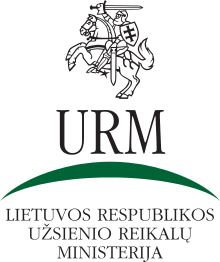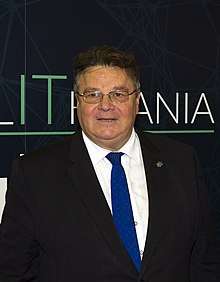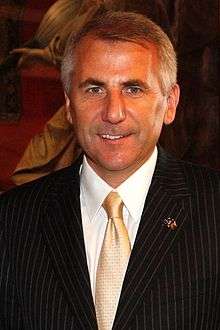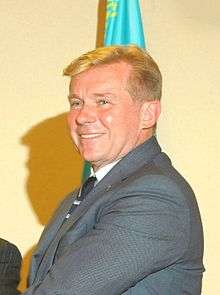Ministry of Foreign Affairs (Lithuania)
The Ministry of Foreign Affairs of the Republic of Lithuania (Lithuanian: Lietuvos Respublikos užsienio reikalų ministerija) is a governmental body of the Republic of Lithuanian that shapes the national policy, and organises, coordinates, and controls its enforcement in the following areas: foreign affairs and security policy: international relations, economic security, foreign trade, protection of the rights and interests of the Republic of Lithuania and its persons and entities abroad; coordination of European Union membership; representing the Republic of Lithuania abroad diplomatic and consular relations, diplomatic service, Lithuanian national and diplomatic protocol, international relations; the policy of cooperation of the Republic of Lithuania; strengthening of expat connections with Lithuania.[1] The Ministry of Foreign Affairs was established on 4 November 1918, shortly after Lithuania reestablished its independence.[2]
| Lietuvos Respublikos užsienio reikalų ministerija | |
 | |
 | |
| Ministry overview | |
|---|---|
| Formed | November 4, 1918 |
| Headquarters | Vilnius, Lithuania |
| Minister responsible | |
| Website | www |
Activity
The head of the Ministry is the foreign minister. The current head of the Ministry is Linas Antanas Linkevičius. He is appointed and revoked by the President of the Republic of Lithuania by motion from the Prime Minister.[3] The foreign minister is subordinate to the Parliament, the President, and the Prime Minister of the Republic of Lithuania. The foreign minister supervises the Ministry, deals with matters that lay within its sphere of competence, signs international agreements, ensures the enforcement of regulations the Ministry is tasked to oversee, files bills, ensures the execution of orders from the Government and the Prime Minister of the Republic of Lithuania, approves Strategic Planning Methodology, issues annual reports, coordinates and controls the work of administrational departments of the Ministry, as well as the activities of diplomatic missions, consular establishments and offices of the Republic of Lithuania to international organizations, file motions to the President of the Republic of Lithuania to award the diplomatic ranks of ambassador extraordinary and plenipotentiary of the Republic of Lithuania, envoy extraordinary of the Republic of Lithuania, and minister plenipotentiary of the Republic of Lithuania, and to the Government of the Republic of Lithuania, to appoint or recall diplomatic representatives (ambassadors extraordinary and plenipotentiary), defines the areas of activity for vice-ministers, and areas of cooperation for the Ministry chancellor.[4]

In his work, the minister is advised by officers of political trust – vice-ministers. The Ministry may not have more than four of them. They organise and control execution of orders, the drafting and approval of draft regulations, and represent the minister by assignment, presenting the minister's political attitudes and decisions to the public.
The analysis, planning, formation, coordination, and enforcement of Lithuania's foreign policy is done by the political director of the Foreign Ministry. The director's functions include high-level representation of Lithuania abroad. The political director is involved in the activities of the Ministry's management, cooperates with the Ministry's administrative departments, domestic and foreign institutions, bodies, and individual partners. The director also supervises the formation, enforcement, and development of the security policy and cooperation with foreign countries, regions, and international organizations, the strengthening of the Eastern neighborhood policy, human rights and democracy, European policy, trans-Atlantic and developmental cooperation, and support of democracy.
The head of the Ministry's administration is the chancellor. The chancellor coordinates and controls the activities of the Ministry's administrative departments, ensures that financial and intellectual resources, assets and information are used optimally to achieve the Ministry's strategic operating goals and objectives.
The foreign minister has an advisory institution, the so-called board.[5]
Structure
By order approved on 26 January 2016, the Foreign Ministry has 19 departments:
- The Policy Planning Department
- The United Nations, International Organisations, and Human Rights Department
- The European Countries Department
- The Developmental Cooperation Department
- The Latin America, Africa, Asia, and Oceania Department
- The Foreign Lithuanians Department
- The European Union Department
- The External Economic Relations Department
- The Economic Security Policy Department
- The Human Resources Department
- The Administrative Department
- The Information Technology Department
- The Financial Department
- The National and Diplomatic Protocol Department
- The Legal and International Contracts Department
- The Consular Department
- The Eastern Neighborhood Policy Department
- The Trans-Atlantic Cooperation and Security Policy Department
- The Information and Public Relations Department
Ministers of Foreign Affairs
Interwar and in exile
| Name | Took office | Left office | Political party |
|---|---|---|---|
| Augustinas Voldemaras | 11 November 1918 | 12 April 1919 | |
| Mykolas Sleževičius | 12 April 1919 | 6 October 1919 | |
| Augustinas Voldemaras | 6 October 1919 | 19 June 1920 | |
| Juozas Purickis | 19 June 1920 | 1 January 1922 | |
| Vladas Jurgutis | 1 January 1922 | 28 September 1922 | |
| Ernestas Galvanauskas | 28 September 1922 | 10 June 1924 | |
| Valdemaras Čarneckis | 18 June 1924 | 25 September 1925 | |
| Mečislovas Reinys | 25 September 1925 | 20 April 1926 | |
| Leonas Bistras | 21 April 1926 | 14 June 1926 | |
| Mykolas Sleževičius | 15 June 1926 | 16 December 1926 | |
| Augustinas Voldemaras | 16 December 1926 | 19 September 1929 | |
| Dovas Zaunius | 8 November 1929 | 12 June 1934 | |
| Stasys Lozoraitis | 12 June 1934 | 5 December 1938 | |
| Juozas Urbšys[6] | 5 December 1938 | 16 June 1940 | |
| Vincas Krėvė-Mickevičius | 17 June 1940 | 22 July 1940 | |
| Stasys Lozoraitis[7] (Chief of Diplomacy) | 16 June 1940 | 24 December 1983 | |
| Stasys Bačkis[8] (Chief of Diplomacy) | 24 December 1983 | 6 September 1991 |
From 1990
Parties LKDP LDDP TS–LKD LSDP NS Independent
| # | Picture | Name | From | Until | Political Party | Cabinet |
|---|---|---|---|---|---|---|
| 1 |  |
Algirdas Saudargas (1948–) |
17 March 1990 | 2 December 1992 | LKDP | Prunskienė |
| Šimėnas | ||||||
| Vagnorius I | ||||||
| 2 |  |
Povilas Gylys (1948–) |
2 December 1992 | 4 December 1996 | LDDP | Lubys |
| Šleževičius | ||||||
| Stankevičius | ||||||
| (1) |  |
Algirdas Saudargas (1948–) |
4 December 1996 | 27 October 2000 | LKDP | Vagnorius II |
| Paksas I | ||||||
| Kubilius I | ||||||
| 3 | Antanas Valionis (1950–) |
27 October 2000 | 5 July 2006 | Independent | Paksas II | |
| 3 | NS | Brazauskas I | ||||
| Brazauskas II | ||||||
| 4 |  |
Petras Vaitiekūnas (1953–) |
6 July 2006 | 28 November 2008 | Independent | Kirkilas |
| 5 |  |
Vygaudas Ušackas (1964–) |
9 December 2008 | 26 January 2010 | Independent | Kubilius II |
| 6 |  |
Audronius Ažubalis (1958–) |
11 February 2010 | 13 December 2012 | TS–LKD | |
| 7 | Linas Antanas Linkevičius (1961–) |
13 December 2012 | Incumbent | LSDP | Butkevičius | |
| 7 | Independent | Skvernelis |
References
- "1155 Dėl Lietuvos Respublikos užsienio reikalų ministerijos nuostatų patvirtinimo". www.e-tar.lt. Retrieved 2017-10-19.
- Eidintas, Alfonsas; Bumblauskas, Alfredas; Kulakauskas, Antanas; Tamošaitis, Mindaugas (2013). The History of Lithuania (PDF). Vilnius: Eugrimas. Archived from the original (PDF) on 2013-12-15. Retrieved 2017-10-19.
- Lithuania's Constitution of 1992 with Amendments through 2006 (PDF). constituteproject.org. 2017.
- "LR Vyriausybės nutarimas dėl Lietuvos Respublikos Užsienio reikalų ministerijos nuostatų patvirtinimo".
- "Lietuvos Respublikos užsienio reikalų ministerijos schematinė struktūra" (PDF).
- Jakštas, Juozas (1992). Nepriklausomos Lietuvos istorija 1918-1940. Chicago: Vydūno fondas.
- Petraitytė Briedienė, Asta (2013). Lietuvos diplomatinės tarnybos šefas Stasys Lozoraitis. Vilnius: Versus aureus.
- Vasiliauskienė, Aldona (1996). Stasio Antano Bačkio gyvenimo ir veiklos bruožai. Vilnius.
Sources
- Lietuvos Respublikos Užsienio reikalų ministrai 1918-1940. Retrieved on 2008-08-10
- Lietuvos Respublikos Užsienio reikalų ministrai 1990 - 2006. Retrieved on 2008-08-10